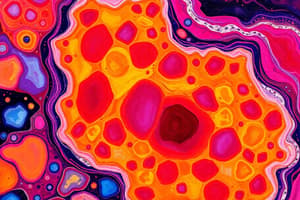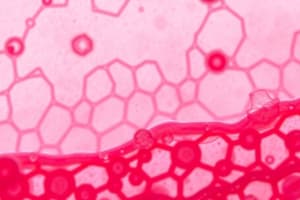Podcast
Questions and Answers
What are the different types of epithelial cells?
What are the different types of epithelial cells?
There are several different types of epithelial cells based on their shape, including squamous, cuboidal, and columnar.
What are the characteristics of epithelial cells?
What are the characteristics of epithelial cells?
Epithelial cells are anchored to a basement membrane, have apical and basal surfaces, and lack extracellular matrix (avascular).
What is the composition of loose connective tissue deep to the basement membrane?
What is the composition of loose connective tissue deep to the basement membrane?
Loose connective tissue deep to the basement membrane contains capillaries.
Why are there several different types of epithelial cells?
Why are there several different types of epithelial cells?
What are the functions of epithelial tissues based on?
What are the functions of epithelial tissues based on?
Flashcards are hidden until you start studying
Study Notes
Body Tissue Composition
- The body is composed of four basic types of tissue: epithelial, connective, muscular, and nervous.
Epithelial Tissue
- Epithelial tissue is one of the four main types of body tissue that forms glands and covers internal and external surfaces in the body.
- It has different structures and functions depending on its location in the body.
- Examples of epithelial tissue functions:
- Forms glandular tissue (e.g., liver, pancreas)
- Lines the lumen of tubular organs (e.g., stomach)
- Lines the inside of body cavities (e.g., thoracic cavity)
- Externally covers the body (e.g., skin) and organs (e.g., heart and lungs)
Studying That Suits You
Use AI to generate personalized quizzes and flashcards to suit your learning preferences.




